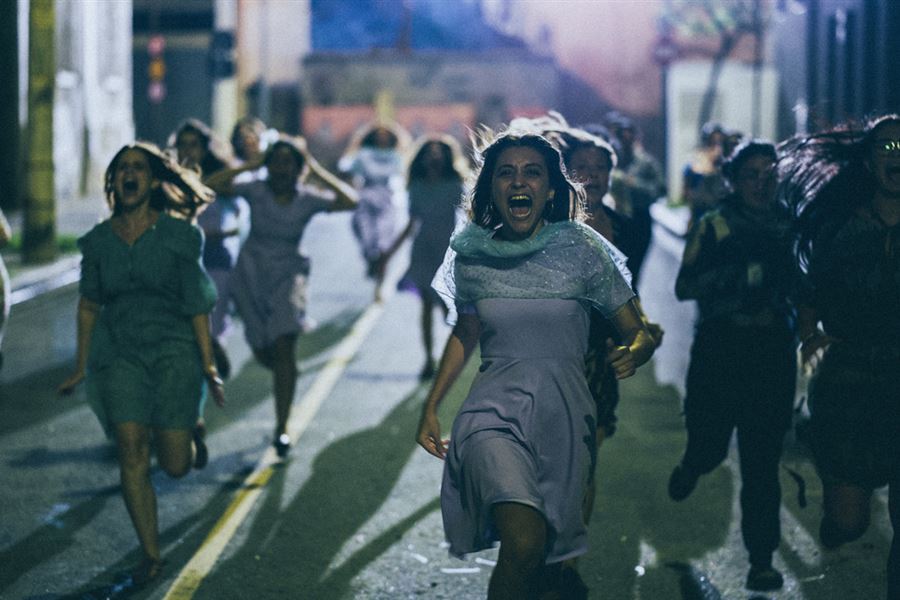This dystopian portrayal of Brazilian society is not far from its lived present. In Medusa, a masked street gang made up of young female fanatics attacks other women.
The gang targets women who, according to their beliefs, have gone astray and chose the path of sin and immoral life. They follow their victims through dark streets, willing to use physical violence and, in the end, force them to confess their sins in a public video that will be shared on social media.
Anita Rocha Da Silveira’s second feature combines different genres, mixing horror with neon musical, satire and occasionally even parody. It corresponds with the acting style of the protagonists that would otherwise seem unnatural and overwrought. In Medusa, they manage to capture the bizarre aspects of their lives, which is funny at first but feels bitterly real at the end. Viewers with some knowledge of Brazil’s political situation – that keeps escalating under President Jair Bolsonaro – know that the things Rocha Da Silveira portrays in her film are already happening in Brazil, with tensions getting higher.
Who is Medusa?
The title takes its inspiration from Greek mythology. Medusa and Poseidon allegedly had sexual intercourse. Athena decided to punish Medusa for losing her innocence, though the act probably was not consensual on her part. Apparently, Athena did not take that into account and turned Medusa into a monster with snakes in her hair. From then on, whoever looked into her eyes would turn to stone. Medusa had its world premiere in the Quinzaine des Réalisateurs section at the 2021 Cannes IFF and it is currently available on HBO Max.
21-year-old Mariana is a member of a religious group and a gang that was founded as an offshoot of the cult. She lives in a superficial, fake world that tries to come across as a picture of purity and perfection. Mariana does not question any of the cult’s ideas and she is a very loyal follower. After being attacked by a woman who was harassed by the gang, she loses her job at a plastic surgery clinic, which she humbly accepts. Having suffered an injury to her face, she would give the clinic a bad name. Apparently, it is not just the cult members who overlook real issues and idolize appearance over what actually goes on in society and inside people.
Trying to find Melissa – an actress who was assaulted many years ago and fell into a coma, which made her into a kind of urban legend – Mariana gets a job at a clinic for long-term coma patients. She befriends a colleague who represents moderate views and, in the language of the cult, tries to lead her astray. Mariana gives in to her desires and starts seeing her life from a different perspective. She clashes with her best friend Michele who also faces a personal crisis; she comes to realize that she is not willing to sacrifice her life for a man who is a model cult member but does not shy away from physical violence.
The movie concludes with a surprising rebellion and physical clash between the male and female members of Father Guilhermo’s cult. In the last minutes of Medusa, there is a lot of shrieking, often discussed as a symptom of hysteria, which feels like an act of liberation, rejection of stereotypes and misogyny that surrounded them. Their movement and cries express unease as it becomes an instrument to present their power and worth.
Acknowledged horror inspiration
Anita Rocha da Silveira does not hide the fact that Medusa was inspired mainly by Brian de Palma and Dario Argento. Specifically, she mentions Carrie (1976) and Suspiria (1977) as main inspiration sources. Yet she also mentions David Lynch. Medusa goes back and forth between these references and a women’s account of Brazil’s status quo. The movie also has a lot in common with Brazil’s recent festival hit Bacurau (dir. Kleber Mendonça Filho, Juliano Dornelles, Jury Prize at the 2019 Cannes IFF). Both films capture a gloomy future that alternates with the present, using a quite unusual – at least in a European context – visual language and storyline. In its overall effect, Bacurau is bolder and more original than Medusa. When it comes to the subject matter and visual style, for instance, its distinct use of neon lights, the movie resembles Divine Love (dir. Gabriel Mascaro, 2019). The main difference between these two films is that, according to Rocha Da Silveira, Medusa is set in a parallel universe of the present; Divine Love takes place in 2027. In a way, Medusa anticipates Divine Love as it captures preparations for radical social transformation in the name of Jesus. Both films reject Christian fanaticism and politics, currently represented by Jair Bolsonaro.
Medusa includes many metaphors and symbols and presents ideas that might not be new. Yet in this compressed 127-minute format and with its topical relevance, it paints a picture of Brazil today, not very well known in our part of the world. At the same time, it is not the type of film that would identify just local Brazilian problems, phenomena and issues. Case in point, the current situation in Slovakia. A deadly cocktail of fanaticism and so-called traditional Christian values and nationalism has escalated to the point that members of the self-proclaimed “dove nation” physically assault and murder people who, based on this ideology, are viewed as enemies who disrupt happy life in “our” country. Medusa’s key message becomes universal across different continents and historical experiences because the alleged threat to traditional values and lifestyle exists almost everywhere.


